“Because I know my mother’s language, I’ve enjoyed exchanging thoughts with other Polynesians to discover our alikenesses and our differences. And because I know my father’s, I can explain to others what we have had here and lost and what we still retain.”
~ Mary Kawena Pukui (1895-1986)
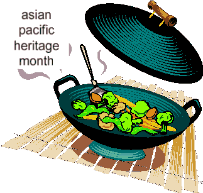
Imagine having a name that is like a poem:
Mary Abigail Kawena ‘ula-o-ka-lani-a-Hi’iaka-i-ka-poli-o-Pele-ka-wahine-‘ai-honua Na-lei-lehua-a-Pele Wiggin Pukui.
The Hawaiian part means: “The rosy glow in the sky made by Hi’iaka in the bosom of Pele, the earth-consuming woman. The crimson lehua wreaths of Pele.”
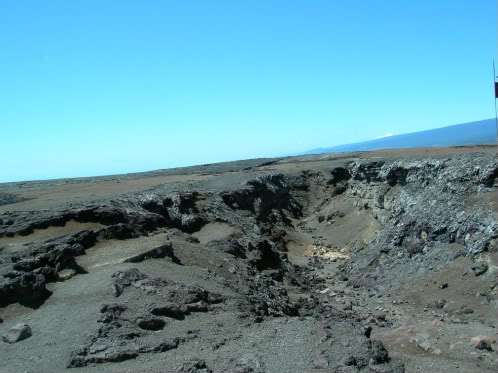 Volcanoes National Park, Island of Hawai’i
Volcanoes National Park, Island of Hawai’i
Now imagine spending the first six years of your life in a remote part of the world, a place of barren lava wastelands and green mountain forests. There are no outsiders, no influences from the Western world. There is only you and your grandmother, Po’ai, a former dancer in Queen Emma’s court, who teaches you everything she knows about ancient Hawai’i, through chants and hula. You learn geneaology, history, folklore, social behavior, herbal healing, music, family history and crafts.
The spoken word is powerful, sacred, and conveys everything you need to know about an entire civilization, so you listen carefully, watch, imitate and remember.
Mary Pukui, or Kawena (kah-VEH-nah), as she was fondly known, is a Hawaiian treasure. The daughter of a Hawaiian mother and a Caucasian father from Salem, Massachusetts, Kawena was a bridge between the old world and the new. Without her life’s work as an author, linguist, composer, dancer, teacher, ethnographer, historian, editor and translator, much of what we now know about the real Hawai’i would have been lost forever.
Her unusual upbringing, of being raised by her maternal grandmother, was authentic to the old Hawaiian custom of hanai. After Po’ai passed away, Kawena returned to her parents’ home, where her father spoke only English, and her mother, only Hawaiian.
By this time, the Americans had taken over Hawai’i. Though the New England missionaries had brought written language, they had also banned Hawaiian in the schools. When she was fifteen, Kawena tried to help a new student, and was severely punished for speaking Hawaiian. Her parents withdrew her from school, but the hurt and humiliation she suffered lasted a lifetime.
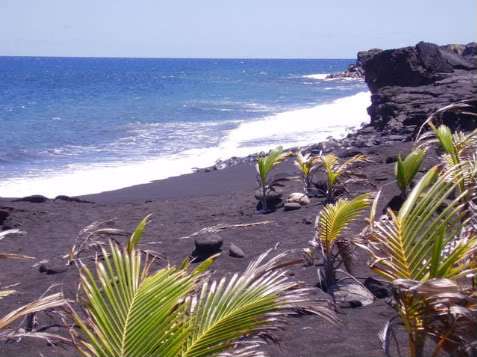 Black sand beach, Island of Hawai’i
Black sand beach, Island of Hawai’i
Kawena grew up respecting both of her cultures, and could think in Hawaiian and English. But she saw how the world was changing, and was afraid that all things Hawaiian would be lost forever. As a teenager, she began to record words, sayings, bits of poems and proverbs that she remembered on scraps of paper. With the help of a neighbor, she also began translating folklore and poetry, and wrote down family stories.
She eventually worked for the Bishop Museum, where she translated Hawaiian newspapers and manuscripts, and gathered oral histories. She recorded more Hawaiian words and expressions on index cards. After 50 years of diligent annotating, her collection of 10,000 word entries became the most detailed, accurate and complete Hawaiian-English dictionary ever published.
And all those scraps of paper? Her lifelong collection of poetical sayings became ‘Olelo No’eau (Bishop Museum Press, 1983), her masterwork, considered to be the “finest compendium of traditional Hawaiian insight and lore, handed down through generations of oral tradition.”
It is easy to see how poetic the Hawaiian language is purely by sound — each vowel is enunciated, and only eight consonants are used — a musical syllabics resembling rolling waves in the sea. But more remarkable is that the Hawaiians thought poetically, describing the world and their emotions using the metaphors of nature. Animism, where every rock, tree, animal or plant has a soul or spirit, was central to their beliefs.
Like the Eskimos with their many ways of describing snow, the Hawaiians described rain in ways very specific to character and location:
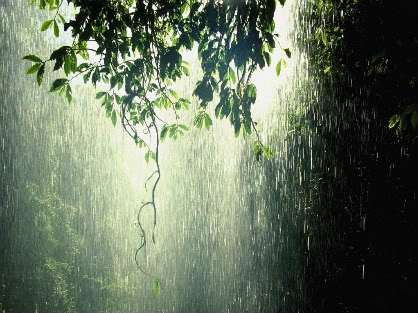
Ka ua hehi ‘ulu o Pi’ihonua.
The rain that treads on the breadfruit leaves of Pi’ihonua.
Ka ua ho’opala ‘ohi’a.
The rain that ripens mountain apples.
Ka ua kani ko’o o He’eia.
The rain of He’eia that sounds like the tapping of walking canes.
Ka ua kapua’i kanaka o Palawai.
The rain of Palawai which sounds like human footsteps.
Ka ua kau la’au o Pahala.
The tree-resting rain of Pahala.
Ka ua Kupunikapa o Lanakila.
The hold-fast-to-the-clothing rain of Lanakila.
Ka ua Lanipa ‘ina o ‘Ulupalakua.
The sky-crackling rain of ‘Ulupalakua.
Ka ua ‘o’ili’ili maka akua.
The rain that appears here and there to denote the presence of a god.
Ka ua po’o nui o ke kuahiwi.
The big-headed rain of the mountain.
(all poetical sayings from ‘Olelo No’eau)
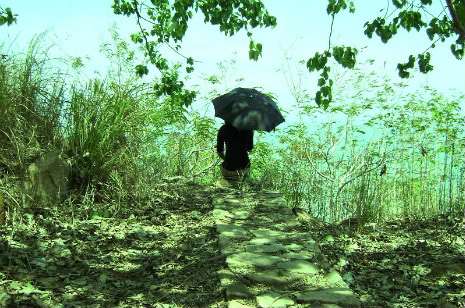
It is easy to see that in such a world, every natural detail is keenly observed, deeply revered, and honored with its own unique lyrical expression. And it is awe inspiring that poetry — whether in the form of chant or song, was the medium of preservation, education, inspiration and entertainment — practiced by commoners as well as kings. A spoken word was exhaled with the breath of the speaker, and once uttered, it was carried by the winds for generations.
I leave you with an original mele hula (a song for the dance), composed by Kawena in the early 1930’s with her mother, Pa’ahana Wiggin. The chant is organized around four indispensable words which denote four directions: luna (above), lalo (below), mauka (inland), and makai (toward the sea), and is often taught to kindergarten children in the original Hawaiian. Picture the children performing a sitting hula while chanting — gesturing above, below, inland, and toward the sea.
E’IKE MAI
(translation below)
I luna la, i luna
Na manu o ka lewa
I lalo la, i lalo
Na pua o ka honua
I uka la, i uka
Na ulu la’au
I kai la, i kai
Na i’a o ka moana
Ha ‘ina mai ka puana
A he nani ke ao nei.
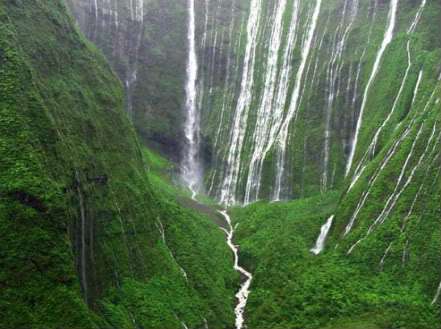
Mt. Wai’ale’ale on Kaua’i, the wettest spot on earth and place of origin, Hawaiian Island chain
BEHOLD
Above, above
all birds in air
below, below
all earth’s flowers
inland, inland
all forest trees
seaward, seaward
all ocean fish
sing out and say
again the refrain
Behold this lovely world.
Mary Kawena Pukui earned two honorary doctorates, and is the only native Hawaiian ever to be nominated for a Nobel Prize in Literature.
For some audio and video samples from the Bishop Museum archives featuring Kawena, click here.
This week’s Poetry Friday Roundup is at Two Writing Teachers.
Quick Pronunciation Guide:
a — ah
e — ay
i — ee
o — oh
u — oo

Her full name reminded me of the children’s book about Ticki Ticky Tembo No Sa Rembo Chari Bari Ruchi Pip Berry Pembo.
I loved this post. It took me back to my vacation in Hawaii.
I especially loved the descriptions of rain.
LikeLike
That last one about No Sa Rembo, was mine.
–John Mutford
LikeLike
Jama, once again, you have given me much to think about. It’s raining today, and I will be naming each drop.
You cannot tell me that Names for Rain would not be a fantastic picture book.
LikeLike
TadMack says: 🙂
The lovely, liquid syllables of the Hawaiian language are so gorgeous — I won’t butcher the poem by trying to read it in Hawaiian but I love knowing the words — and her name is gorgeous — what a treasured child she must have been.
Thanks for sharing this. And I agree with Sara! What a great name for a book!
LikeLike
I’d love to have started my life in a culture unhurried enough to be so observant of the natural world.
It’s raining here too, and I really appreciate this lens for seeing it differently.
LikeLike
What a lusty, lusty post…
Always learning over here at your place, Jama. Thanks…
LikeLike
That’s beautiful.
I am obsessed with lullabies (world, traditional, contemporary, you name it), and one of my top-five favorites ones — I mean, it’s SO BEAUTIFUL — is a Hawaiian one. It’s called “He Punahele,” and I think it’s about the ocean. It is so gorgeous. It instantly soothes me. Lovely, lovely melody, and this recording has ocean waves behind it.
Jules,
7-Imp
LikeLike
I don’t think I’ve ever read Tikki Tikki Tembo — must check it out.
I liked the rain descriptions too — mostly because of how specific they were, how they humanized nature. Reminded me of how Native Americans name people.
LikeLike
Yes, I like that — Names for Rain.
Reading through Olelo No’eau jars my thinking — it’s good for getting out of ruts, when you’re tired of the same old metaphors.
LikeLike
Re: TadMack says: 🙂
Credit must also go to Kawena’s father, Henry Wiggin — for when Po’ai asked permission to hanai the newborn Kawena, he was open-minded enough to hand his child over to her. Kawena was eternally grateful to him for that.
LikeLike
Much of modern man’s stress and anxiety comes from being detached from nature. Stopping to listen to the rain is a good thing.
LikeLike
You’re welcome!
LikeLike
“Punahele” means favored child. Kawena was Po’ai’s punahele, the one chosen to receive the valuable knowledge of the previous generation.
That lullaby sounds really beautiful!
LikeLike
“tree-resting rain” ah my soul I love that!
It’s raining here today and although I was wishing we could have taken the children out for a nature walk this afternoon, I have enjoyed watching the rain through the library windows. It is a “me-resting” rain today.
Lovely photos with this wonderful post too. Thanks!
LikeLike
Lovely. Thank you for sharing her story, and for all those lovely names for rain (rather like the Inuit having so many words for snow, combined with ancient Norse practice called kenning).
LikeLike
Sounds like you’re having a lovely cozy day inside. I like the “me-resting” rain :).
LikeLike
Glad you liked being rained on today ;).
LikeLike
What an incredible life!
We’re moving at such a break-neck speed away from all of our native cultures, and yet, to survive our modern selves and ways, I can’t help but believe we need to go back in their direction…
Mary Lee
LikeLike
Yes, I totally agree. The native Hawaiians fished and farmed according to their need for survival. The idea of exploiting these natural resources “for profit” didn’t come until Western influence. First there was sandalwood trade, and then the sugar plantations, etc.
LikeLike